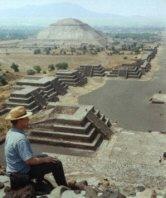Teotihuacán
One of the major civilizations of Meso-America, flourished around 100 - 900.
Located in the north east of the valley of Mexico, the valley of Teotihuacán became the site of America's largest city before the European conquest. At its height, about 650 - 750, the city of Teotihuacán had an estimated 150,000 inhabitants.
The city was layed out to a master plan. Two major avenues crossed each other at right angle, dividing the city into quarters. The Avenue of the Dead was the main avenue; it was directed north-south at 16 degrees east of north.
The city had over 600 pyramids, massive solid structures built from bricks that carried a temple on a top platform. The largest of these, the Pyramid of the Sun, rises to 64 m at platform level.
 The various quarters of the city contained buildings of quite different sizes. The houses of nobles were wide and lofty, while the labourers' quarters were cramped and had very narrow passages. Residential palaces along the Avenue of the Dead were enclosed in walls that protected a square of 60 x 60 m from the views of passers-by. The houses around the central open-air courtyard had flat roofs of cedar beams covered with brush and mortar. The walls of rooms were plastered and luxuriously covered with paintings of religious rituals and processions.
The various quarters of the city contained buildings of quite different sizes. The houses of nobles were wide and lofty, while the labourers' quarters were cramped and had very narrow passages. Residential palaces along the Avenue of the Dead were enclosed in walls that protected a square of 60 x 60 m from the views of passers-by. The houses around the central open-air courtyard had flat roofs of cedar beams covered with brush and mortar. The walls of rooms were plastered and luxuriously covered with paintings of religious rituals and processions.
Houses in workers' suburbs were of similar design but had much smaller rooms without decoration, and the walls of the living compounds were set close together.
Teotihuacán, the "City of the Gods" in the Aztec language, was the most influential civilization of Meso-America. Pottery and blades, knives and other sharp utensils made from obsidian found their way from the factories in Teotihuacán into all Meso-American regions.
Teotihuacán was sacked and burned by the Toltecs c. 900 and went into decline soon after.

The Pyramid of the Sun.
home
 The various quarters of the city contained buildings of quite different sizes. The houses of nobles were wide and lofty, while the labourers' quarters were cramped and had very narrow passages. Residential palaces along the Avenue of the Dead were enclosed in walls that protected a square of 60 x 60 m from the views of passers-by. The houses around the central open-air courtyard had flat roofs of cedar beams covered with brush and mortar. The walls of rooms were plastered and luxuriously covered with paintings of religious rituals and processions.
The various quarters of the city contained buildings of quite different sizes. The houses of nobles were wide and lofty, while the labourers' quarters were cramped and had very narrow passages. Residential palaces along the Avenue of the Dead were enclosed in walls that protected a square of 60 x 60 m from the views of passers-by. The houses around the central open-air courtyard had flat roofs of cedar beams covered with brush and mortar. The walls of rooms were plastered and luxuriously covered with paintings of religious rituals and processions.